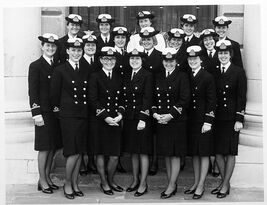|
By Dick Martin  No, not the bird!! With all the WWII history I have read, I have never seen or heard the word Wrens referred to for women. I was introduced to them when they were mentioned in a Netflix documentary that extoled their part in WWII. The Women’s Royal Naval Service (WRNS: popularly and officially known as the Wrens) is probably equivalent to the US NAVY WAVES. The Wrens were formed in 1917 during the First World War. On October 10, 1918, nineteen-year-old Josephine Car from Cork became the first Wren to die on active service, when her ship, the RMS Leinster, was torpedoed. By the end of the war, the WRNS had 5,500 members, 500 of them officers. In addition, about 2,000 members of the WRAF had previously served with the WRNS supporting the Royal Naval Air Service and were transferred on the creation of the Royal Air Force. The Women’s Royal Naval Service (WRNS popularly and officially known as the WRENS) was the women’s branch of the United Kingdom’s Royal Navy. First formed in 1917 for the First World War, it was disbanded in 1919, then revived in 1939 at the beginning of the Second World War, remaining active until integrated into the Royal Navy in 1993. WRNS included cooks, clerks, wireless telegraphist, radar plotters, weapons analysts, range assessors, electricians and air mechanics. Wrens were prominent as support staff at the Government Code and Cypher at Bletchley Park as operators of the bombes and Colossus used to break codes and cyphers. At the beginning of the Second World War, Vera Laughton Mathews was appointed as the Director of the re-formed WRNS, the WRLNS, in 1939 with Ethel (Angela) Goodenough as her deputy. The WRNS had an expanded list of of allowable activities, including flying transport planes. At its peak, in 1944, it had 75,000 active service women. During the war, 102 WRNS members were killed in action and 22 wounded in action. One of the slogans used in recruitment posters was “Join the Wrens and free a man for the fleet”. The WRNS remained in existence after the end of the war, although Mathews retired in 1947 and Goodenough died the year before. In the 1970s, it became obvious that equal pay for women and the need to address sexual discrimination meant that the WRNS and the Royal Navy would become one organization. The key change was that women would become subject to the Naval Discipline Act 1957. Vonla McBride, who had experience in human resource management, became the Director of the WRNS in 1976. Members of the WRNS were subject to the same discipline as men by the next year. In October 1990, during the Gulf War, HMS Brilliant carried the first women officially to serve on an operational warship. That same year, Chief Officer Pippa Duncan became the first WRNS officer to command a Royal Navy shore establishment. The WRNS were finally integrated into the Royal Navy in 1993, when women were allowed to serve on board navy vessels as full members of the crew. Female sailors are still informally known by the nicknames “WRENS” and “Jennies” (Jenny Wrens”) in naval slang. Before 1993, all women in the Royal Navy were members of the WRNS except nurses. Nurses joined (and still join) Queen Alexandra’s Royal Naval Nursing Service , Medical and dental officers, who were commissioned directly into the Royal Navy, held RN ranks and wore WRNS uniform with gold RN insignia.
0 Comments
|
Categories
All
Archives
October 2023
|